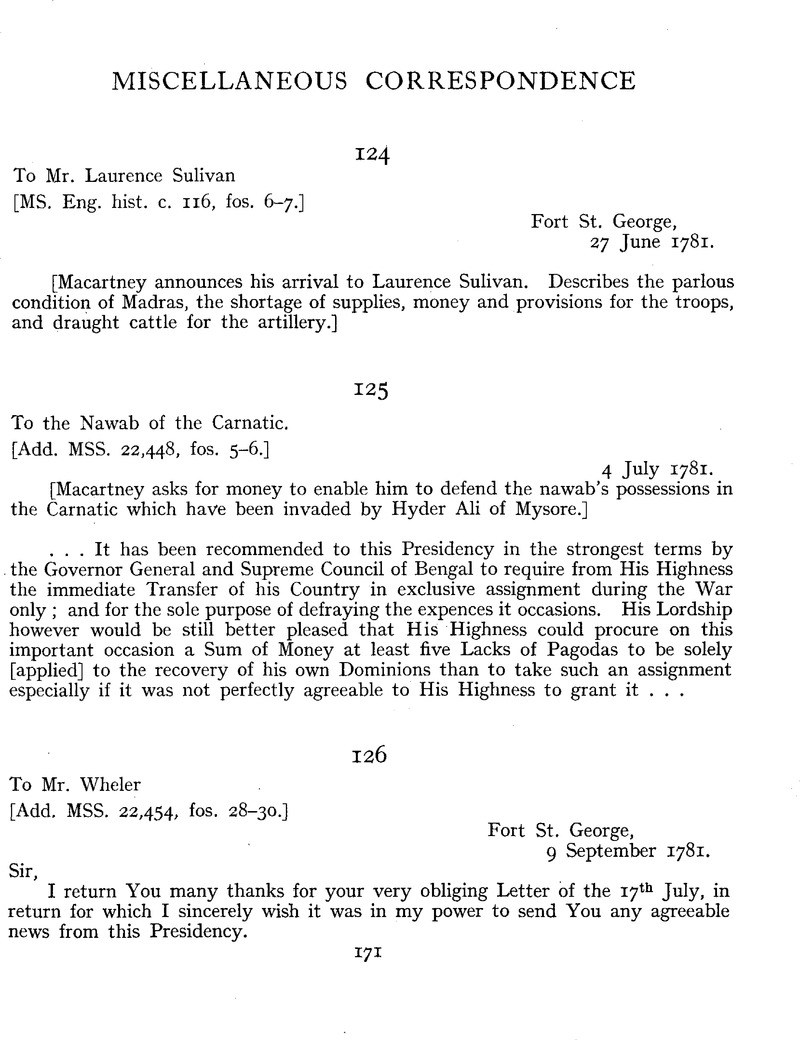No CrossRef data available.
Article contents
Miscellaneous Correspondence
Published online by Cambridge University Press: 24 December 2009
Abstract

- Type
- The Private Correspondence of Lord Macartney (1781–1785)
- Information
- Copyright
- Copyright © Royal Historical Society 1950
References
page 178 note 1 Commanded the squadron sent to the Cape of Good Hope in 1781. After his fight with Suffren in Praya Bay, Fox observed that he was more formidable in parliament than on the ocean.
page 178 note 2 This must be Samuel Johnson, a civil servant dating from 1754.
page 186 note 1 Welbore Kllis (afterwards Baron Mendip) was a Secretary of State in 1782.
page 187 note 1 Sihbandi troops were employed in the police and revenue departments.
page 191 note 1 Thomas Frederick Mackenzie Humberstone. Died of wounds in 1783.
page 198 note 1 Bonnevaux.
page 200 note 1 Sir John Coxe Hippisley (1748–1825). At one time pay-master of Tanjore. Left India in 1789. M.P. for Sudbury.
page 200 note 2 Light two-wheeled horse carriage.
page 201 note 1 George Andrew Ram entered Madras civil service in 1767. Coroner in the time of Pigot.
page 211 note 1 In 1800, as a result of Lord Clive's reforms, the Governor of Madras relinquished his allowances for mintage and coral consulage.
page 220 note 1 Porus was the Indian King defeated by Alexander the Great at the battle of the Hydaspes (326 b.c.) Apelles was the court painter of Macedon.
page 220 note 2 The Rana of Gohad was originally an obscure Jat landholder who rose to power during the anarchy of the eighteenth century. His state, between Etawah and Gwalior, was ceded to Gwalior in 1805.
page 220 note 3 Philip Stowey, appointed Civil Architect by the Directors in 1777. Resigned and returned to England in 1786.
page 220 note 4 Marcus Vitruvius Pollio, Roman architect and engineer.
page 220 note 5 Probably George Maule who entered the service in 1770. Acting Chief Engineer. Killed before Pondicherry in 1793.
page 220 note 6 George Willison arrived at Madras in 1774. Painted portraits of the Nawab, Muhammad Ali.
page 220 note 7 James Peter Auriol was Secretary to the General Board at Calcutta in the time of Hastings.
page 223 note 1 Sir William Jones (1746–1794), the celebrated Welsh orientalist.
page 223 note 2 Jonathan Shipley (1714–1788).
page 223 note 3 Daughter of Stephen Poyntz of Midgham in Berkshire. Her husband was John, first Earl Spencer (1734–1783).
page 223 note 4 Lords Antrim and Bellomont, both Irish peers. Antrim was offered the order of St. Patrick but refused to resign the order of the Bath.
page 223 note 5 Sir George Pocock (1706–1792). Succeeded Admiral Watson in India in 1757. Returned to England in 1760.
page 225 note 1 First Lord of the Treasury in the Fox-North Coalition.
page 226 note 1 Henry Flood (1732–1791), the famous Irish leader.




